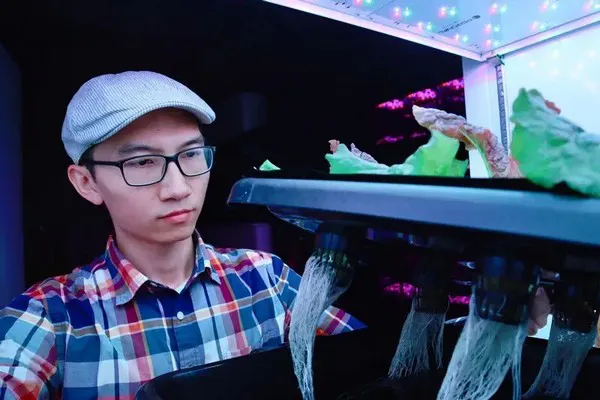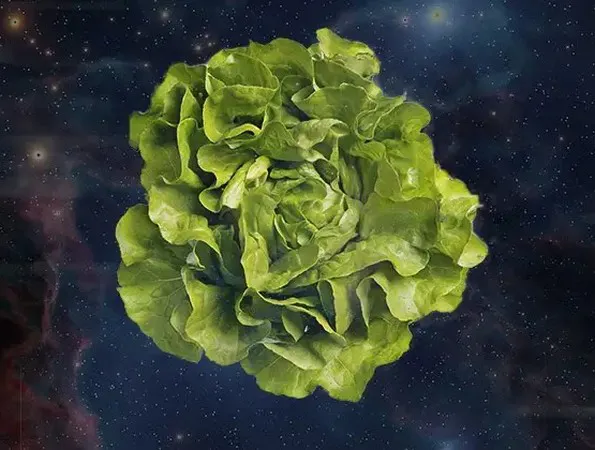Growing food in space is fraught with daunting challenges, including extreme environmental stressors like radiation and microgravity. Qingwu (William) Meng, a University of Delaware assistant professor of controlled-environment horticulture, is an expert on plant growth and light, which, as you’ll remember from your elementary school science or Ms. Frizzle’s Magic School Bus, is an essential component in turning a seed into a mature plant.
Meng received an Early Career Investigation grant from the National Aeronautics and Space Administration (NASA) to investigate light optimization for growing food in space. Specifically, he’ll investigate how changing light conditions over time can optimize lettuce productivity and nutritional quality under super-elevated carbon dioxide and low relative humidity.

Isn’t all of that carbon dioxide in space good for plants? Well, it’s not so simple. Typically, plants respond positively to increased CO2 concentration, but only up to a certain point. For example, at the International Space Station (ISS), carbon dioxide concentration is high, averaging around 2,800 parts per million compared to 417 parts per million on Earth. Previous space research illuminated which crops thrive and struggle under super-elevated CO2 and low relative humidity. Some leafy greens made the cut.
“We want to see how we can optimize lighting to maximize yield and nutritional value of leafy greens while using little of the very precious energy on the space station,” said Meng, who is part of the Department of Plant and Soil Sciences within the College of Agriculture and Natural Resources.
In Earth’s CO2 conditions, researchers have analyzed how plants respond to light quantity and quality. But in space’s super-elevated CO2 conditions, humans have a lot to learn.
“For space crop production, we need a deeper understanding into plant physiological responses to light, CO2, and humidity,” said Meng. “All of these factors interact to influence plant growth and development.”
So, of all of the delicious produce out there, why study lettuce? Well, the well-known leafy vegetable is a model crop in indoor crop research; additionally, NASA tests determined lettuce to be one of the highest-yielding crops for space crop production.
“Lettuce is an ideal crop for research because it grows quickly and is low-maintenance,” Meng said. “What we learn from lettuce is typically transferable to other leafy greens. Through this NASA grant, we will quantify lettuce’s growth rate and nutritional value under different lighting conditions.”
Whether you’re an astronaut or an Earthling in another field, the nutritional value of fresh leafy greens is high, an important boost to your physical and psychological health. (Iceberg lettuce has fewer nutrients than most other forms of lettuce and other leafy greens.)
In approximately one-month cycles over the course of a year, Meng and UD student researchers will take a lettuce crop from seed to harvest, allowing for the replicability of research results. One experiment focuses on light quality optimization over time; the other addresses light quantity over time.

“Whether these indoor growers are here on Earth or in space, they’re generally using fixed light settings. But plant growth is a dynamic process,” Meng said. “There is much more room for improvement of light use efficiency if we tailor the light to each plant growing phase.”
Previous research has shown a plant’s age is key in determining how the plant responds to light and other environmental factors.
“By understanding this unique response, considering the plant age as an element, we can further optimize the entire plant growth process,” Meng said.
What space crops can teach us on Earth
You might be thinking: Why study plant growth in outer space? We have enough problems to solve here on Earth. Falling into this oversimplification trap fails to recognize the innovations that litter the 21st century. The relatively limited time that humans have spent in space has already brought forth innovations like GPS, accurate weather prediction, solar cells, and ultraviolet filters. That’s not to mention ongoing research in combating disease, 3D printing, and quiet supersonic transport over land.
Like the goals of this NASA research project, understanding how to grow more food using less space and energy is the exact type of innovation the Earth needs to curb agriculture’s role in climate change. This type of challenge is in good hands at UD — one of the nation’s select few land-grant, sea-grant, and space-grant universities. Having worked on many indoor growing research projects with both Earth- and space-based objectives, Meng sees the applicability of research results in either venue. And the agricultural industry and its consumers stand to gain a lot.
“What we learn through Earth-based controlled-environment agriculture is applicable to space crop production, and the opposite is also true,” said Meng, who teaches courses in UD’s sustainable food systems major and is an adviser to the Hydroponics Club. “What we learn in space can be applied to indoor vertical farming and greenhouse production industry.”
Additionally, as Meng illustrates, the future favors innovative thinkers. Playing the main character in the movie The Martian, Matt Damon, grew potatoes on Mars, which might only seem like science fiction. But with the breakneck speed of technology development, inhabiting other planets may come sooner than you think.
“In the future, it is inevitable that humans are headed to live in space and on other planets,” Meng said. “Research is often ahead of its time. Space research is no exception. We need to think about what life will be like many years down the road. We can’t wait to solve a problem when the problem is right in front of us. We must be proactive.”
For more information:
University of Delaware
www.udel.edu
